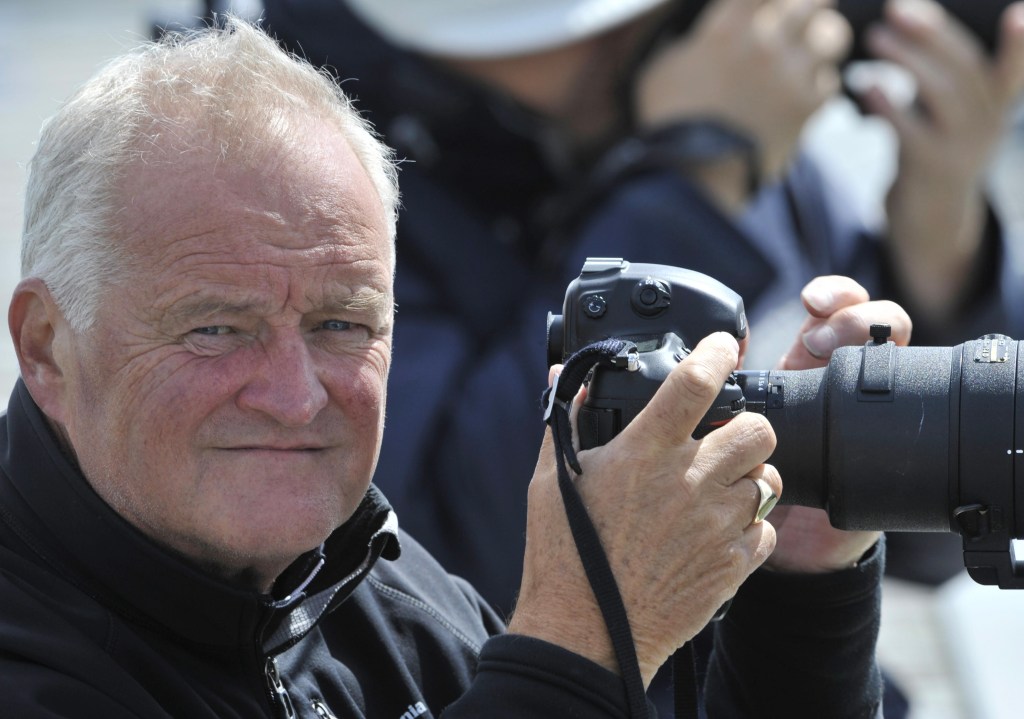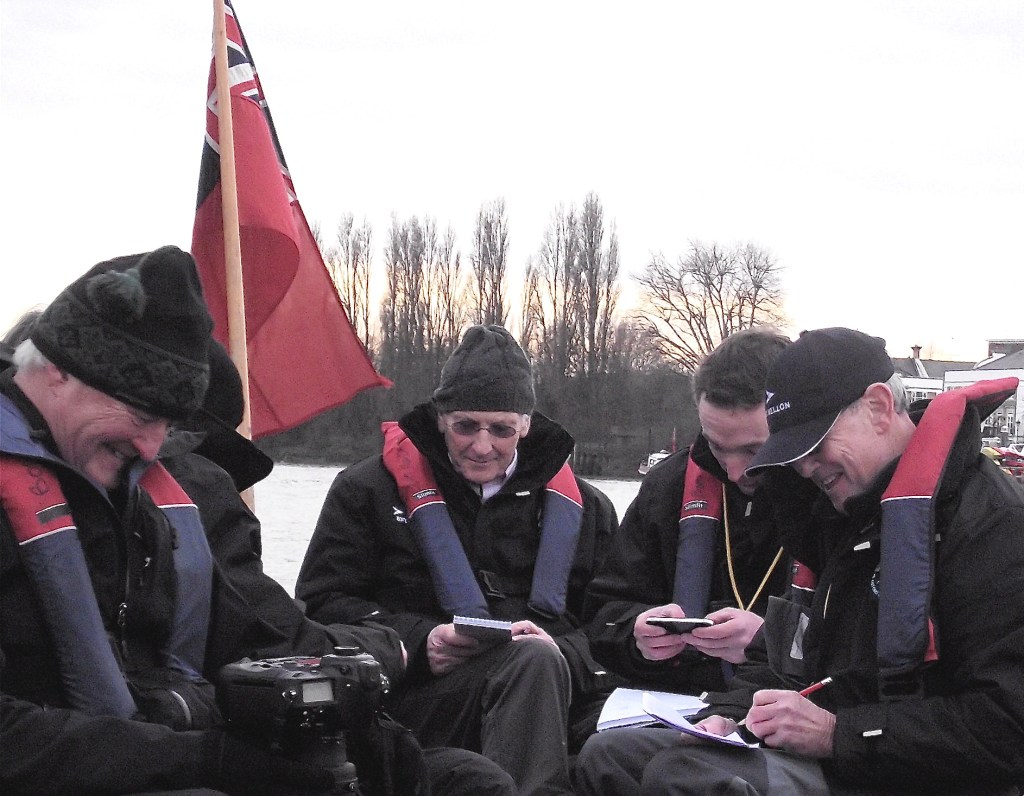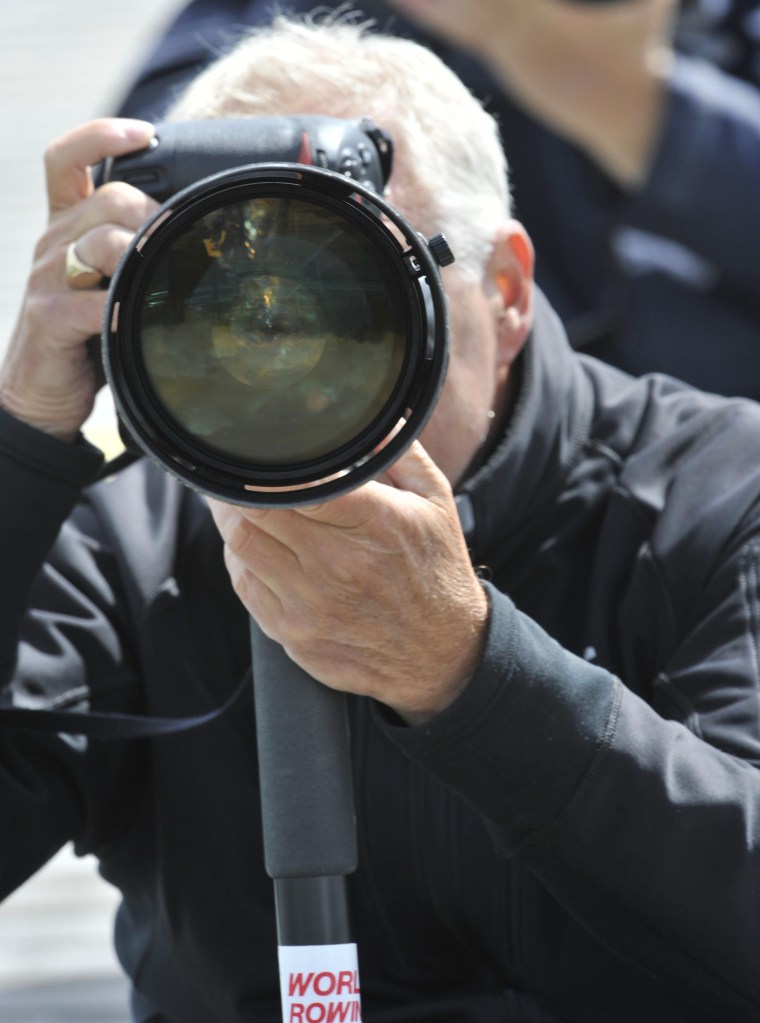
26 April 2023
By Chris Dodd
Chris Dodd recalls the life and times of Peter Spurrier, the greatest photographer on the towpath.
As I write this, I am inspired by an image on the wall of my ‘den’ that shows the Tideway Scullers Great Eight passing Cambridge BC on their way to winning the Head of the Charles Regatta in a Boston snowstorm. The crew consists of eight of the world’s best scullers, identified by their national flags alongside their seats. It is a wonderful shot by Peter Spurrier, a master of the shutter, who has died of a heart attack aged 77.

Pete’s magic ingredient was his sixth sense, and with it he captured the blood, sweat and glory of rowing the world over. Whether he fashioned his sixth sense or was born with it, he made magic during the dawn-to-dusk hours he spent beside lakes, rivers and seas in all weathers. He knew that picking the spot, whether in a set piece or a paparazzi moment, was as crucial as calculating exposure or shutter speed. He enjoyed a ‘long and storied career as the dean of rowing photographers’, wrote rowing photographer Ed Hewitt in row2k. Chip Davis’s tribute in Rowing News says that Spurrier was ‘perhaps the best rowing photographer in the world, and certainly the most prolific’. I would endorse that after deleting ‘perhaps’.
Spurrier began taking ‘snaps’ as a teenager. He joined Staveley Road Secondary Modern School’s rowing programme at Chiswick Rowing Club on the Tideway in London, later moving to Quintin Boat Club. After leaving school he took an apprenticeship with a firm of industrial instrument makers and spent several years as an engineer, including two at sea, before joining his family’s luxury tiling business in 1972. Flexible hours allowed study for a degree in photography at Surrey College of Technology, followed by further specialist study at the London College of Printing.
Rowing arose in front of his lens at a chance meeting in 1981 while taking pictures of wildlife in Thorpe Park, Surrey. The GB squad was training on the lake, and while chief coach Penny Chuter discouraged the snapper from aiming his camera at the crews, implying that he was spying, Mike Spracklen invited him aboard his coaching launch to show off his young protégé, Steve Redgrave.
The photographer was given his first assignment – in lieu of a fee – for the American publication Rowing News after he complained gently that the copyright of a terrific cover picture of an Olympic rower belonged to him, not the athlete’s sponsor as implied. Spurrier’s images have adorned Rowing News ever since, and he was working on a feature to celebrate the magazine’s first 30 years when he died.
Spurrier was also official photographer for British Rowing during its stealthy climb to the peak of international rowing from 1996 onwards, guided by performance director Sir David Tanner and chief coaches Paul Thompson and Jurgen Grobler. Spurrier fed stunning pictures to Regatta magazine and the eclectic RowingVoice. His talents were also at work Downunder, for in 1987 he met Guy Hebblewhite at the World Championships in Copenhagen, an able photographer commissioned to take pictures for Rowing Australia but lacking experience of such regattas. Spurrier showed him the ropes, and thus began a partnership with Hebfotos, an agency based in Adelaide run by Hebblewhite and Cynthia Judd.

While Spurrier was competitive behind the camera, he was calm and good company when work was over for the day. Judd recalls the time when Guy had succumbed to his ailments and was in a nursing home. ‘Pete and his partner Karon came to Adelaide to see him. How Guy’s face lit up when Pete walked through the door was really something to see. After we stopped travelling to Europe, we never forgot Pete, corresponding over the years and looking for his face on television at Olympic events.’
Pete was easy to work with as a writer and as an editor. For years he and I wrote, illustrated and edited world championship and Olympic spreads for Rowing+Regatta, Regatta and RowingVoice, and in 2011 we curated an exhibition at the River & Rowing Museum of 65 of Pete’s glorious images. Included were iconic pictures like the Great Eight in a Charles River snowstorm mentioned above, and the famous handshake in Atlanta in 1996 when stroke Matt Pinsent extended an arm behind his back to his bowman Steve Redgrave a good five minutes after the pair, completely drained, won Olympic gold by a whisker. The show drew on many aspects of rowing – morning mists on rivers and lakes, racing shells and coastal boats, sunrises and sunsets, conventional scenes and electric moments such as Mahé Drysdale flying off the block or Iztok Cop surrounded by swimmers bearing flags of Slovenia at the time when Yugoslavia fragmented into separate states.

The chosen images in the exhibition illustrated a mood, an ambience, a little giveaway of concentration or nervousness, the ingredients that make a picture unique. Spurrier’s eye reveals telling incidents that make a story stand out – quirky rituals before a race, or something that may affect an event’s outcome, such the frogman who popped up in front of the photographer bearing a massive tangle of weed that he was clearing from the course at the Beijing Olympic regatta course in 2008.

A kind man who helped colleagues and newcomers, Pete’s mischievous side kept him ahead of the national newspaper and agency photographers whose appearances at rowing venues were occasional. Snappers lying on start pontoons to shoot crews as they gird up before the green starting light alights are required to stay still for two minutes before the start and remain still for some time after. Pete’s ploy was to position himself on a lane adjacent to the one he really wanted, and then with half-a-minute to go before the ‘no move’ curfew kicked in, he skipped over to his real choice while leaving his disciples at sixes and sevens.
I witnessed a classic Spurrierism at the 2000 Olympics, when on finals day at Penrith Lakes, Sydney, he and I were disgorged from a bus at dawn to clear security and walk across the bridge over the recovery lane to the media island. Pete stopped to clock a lone sculler paddling into the sunrise. Half a dozen snappers halted abruptly to grapple for their cameras and take aim. Who was that I asked Pete later. ‘Haven’t a clue, but got them all wondering, didn’t it, and I got to the stand first to bag the seat I wanted,’ said he.
Pete covered rugby and cricket for newspapers when he could get away from rowing, but his shutter on rowing’s undertow, its fractions of despair and delight on dancing water won him awards, including the British Association of Rowing Journalists (BARJ) Journalist of the Year and a special commendation by Britain’s Sports Journalists Association.

Ed Hewitt was one who profited from Spurrier as mentor. ‘He took countless rowing photographers under his wing,’ Ed says, ‘sharing with them tricks of the trade, teaching how to read the ‘room’ at the start line, finish line, and medals stand, and bringing his hard working but calming presence into play. He was a consummate pro, never getting caught up in politics or rivalries, but after a world championship week in his company, you knew what to do, where to be, who to trust – and what not to do, where not to be, and who not to trust. Peter had the situation wired, and held none of it back from young photographers who could use and appreciate the dean’s wisdom.’
Hewitt also lauds Pete the storyteller. The row2k editor recalls ‘serious, hilarious, historical, and even ribald stories along the banks of racecourses worldwide. He was never a bore. A session alongside Spurrier was a don’t-miss opportunity at Henley, Worlds, Olympics, great Thames and Charles “head of river” time trials and anywhere else that he was behind the shutter.’

Pete’s pictures will record, enlighten and delight for many years to come, but from now on the rowing world must face up to the absence of the lone camera genius with the magic eye, and grant him rest in peace.
Peter was the eldest son of Donald Spurrier, an engineering fitter, and Beryl née Thomas, accounts manager at Cherry Blossom Shoe factory. He is succeeded by his former wife Roberta and their children, Blanche, Donna and Scott, his partner Karon and his brother Kevin.
Peter’s archive of rowing images as well as his photos of rugby, cricket, and other sports are on his business website, Intersport Images.
Peter Donald Spurrier, born 26 April 1949, died 18 April 2023.

